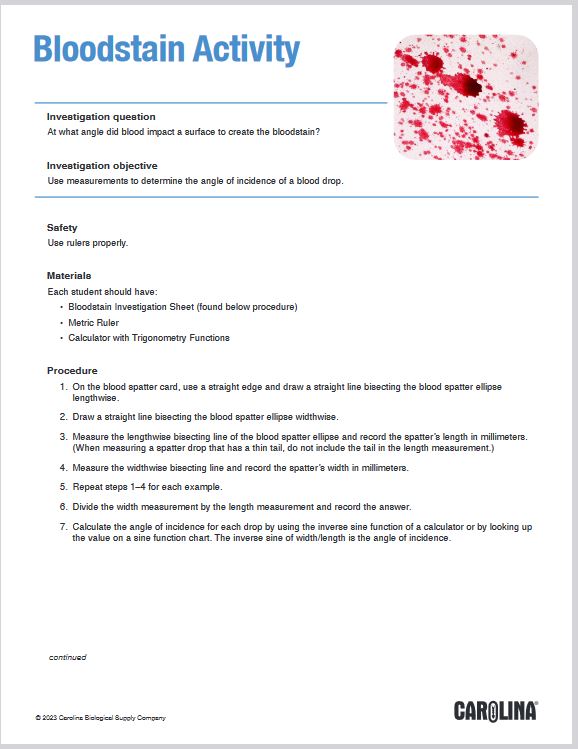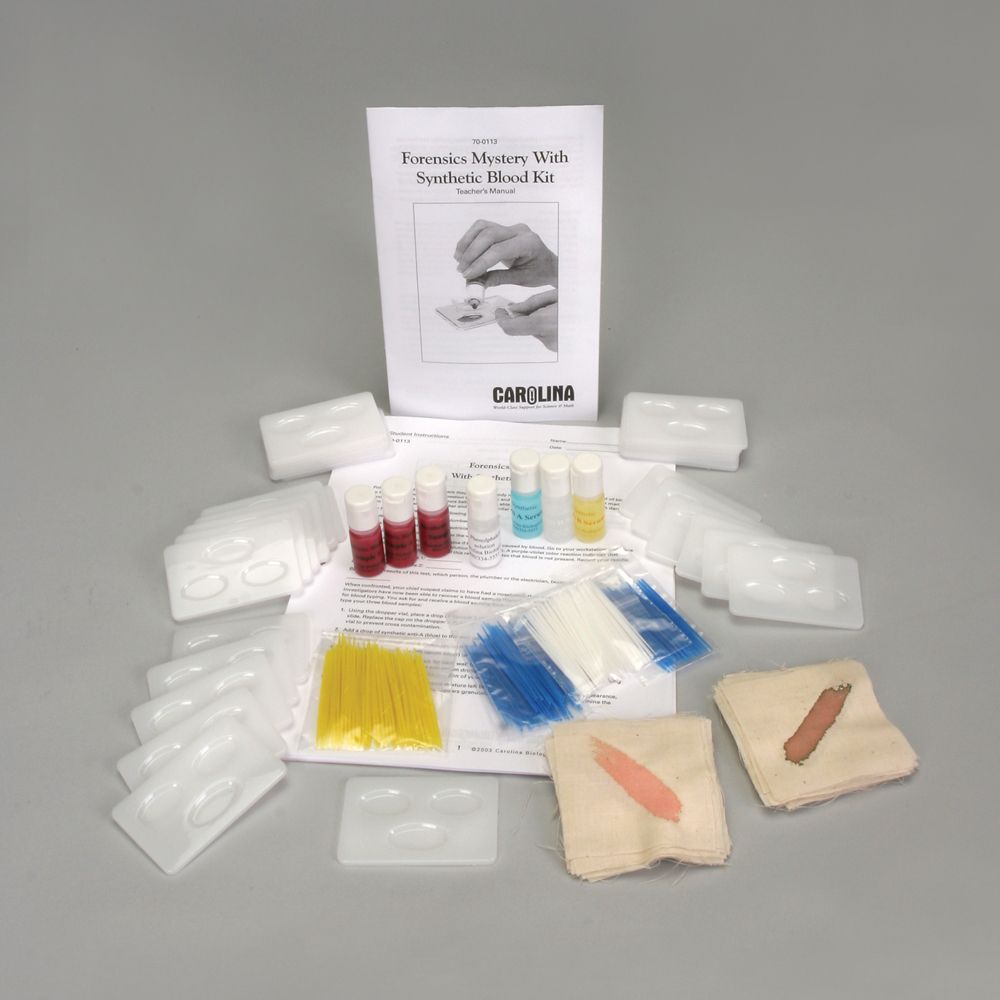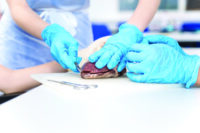Blood evidence can be analyzed as either biological or physical evidence, making it a powerful specimen for teaching forensics across multiple disciplines. Using biology concepts, investigators can use blood to identify individuals by blood type and DNA.
When a suspected sample of blood is discovered at a crime scene, real world applications of chemistry such as presumptive blood testing with luminol can confirm or deny the presence of blood. And at scenes with blood spatter, the size and location of blood droplets can be analyzed using physics concepts to recreate the incidents of the science by calculating angles of incidence.
This collection of activities provides unique ways of teaching and investigating blood evidence in your classroom.
- Luminol Blood Detection Activity (Chemistry)
- Bloodstain Activity (Physics)
- Blood Typing Activity (Biology)
Luminol Blood Detection Activity (Chemistry)

Investigation question
Is the substance at the crime scene blood or an unknown substance?
Investigation objective
Use a luminol reaction to perform a presumptive blood test.
Safety
Follow established laboratory safety practices and use appropriate personal protective equipment (PPE) such as gloves, chemical splash goggles, and lab coats or aprons.
Materials
- Carolina® Luminol Reactive Forensic Blood, 250 mL (or your preferred luminol reactive substance)
- Multiple Blood-like Substances (simulated blood, ketchup, hot sauce, etc.)
- Surface for Blood Stains (fabric or wood preferred)
- Luminol, 0.18 g
- Clorox 2 Powder, 10 g
- Water, 60 mL
- Small Spray Bottle (preferred) or Drop Bottle
- Luminol Blood Detection Student Investigation Sheet (one per student)
Teacher Preparation
1. Prepare the luminol solution the morning of the investigation.
a. Combine 0.18 g of luminol, 10 g of Clorox 2 powder, and 60 mL of water in a 100-mL beaker. Stir the mixture with a glass stirring rod.
b. Allow the mixture in the beaker to sit for 10 minutes.
c. After at least 10 minutes have elapsed, decant the luminol/Clorox 2/water
mixture into the labeled spray bottle or dropper bottles.
d. Repeat steps a–c for as many luminol spray solutions as you have student groups.
2. Create a mock crime scene by applying a drop of luminol reactive blood and non-reactive blood substances on a piece of fabric or on a wood table. Create as many mock crime scenes as you have student groups.
Procedure
- Observe the crime scene and record your observations for each stain.
- Make a prediction on which stains are blood and which are not based on your observations.
- Obtain luminol solution from your teacher.
- Turn off the classroom lights and spray each stain with the luminol solution. When luminol reacts with blood, it produces blue light without heat (a reaction called a chemiluminescent reaction). Luminol does not produce blue light when reacting with other substances. Record your results for each stain in the luminol column.
- Based on your visual observations and luminol tests, write a conclusion on which bloodstains are and are not blood. Explain your reasoning.
- Clean and dispose of lab supplies as directed by your teacher.
Analysis
- Did your predictions match your conclusion? Explain why you think they did or did not.
- Describe what can and cannot be learned from a visual observation of stains that appear to be blood.
- What type of a reaction is the luminol reaction?
- Explain why it is valuable for forensic investigators to perform chemical blood tests, such as the luminol test you performed, when analyzing suspected blood stains.
- Research questions.
- a. What causes luminol to glow during a reaction?
- b. What chemically causes luminol to react with human blood and not with other substances?
- c. Can investigators be confident in the results of luminol tests or are there additional factors to consider that may cause a false positive or negative result?
Sample Answers
| Sample | Bloodstain A | Bloodstain B | Bloodstain C | Bloodstain D |
|---|---|---|---|---|
| Observations: (color, texture, stain shape | Bright red, thick, and tear drop shaped | Dark red, thin, tear drop shaped | Dark purple, thick, streaked line | Pale red, light and thin, smeared |
| Prediction: | Blood | Not Blood | Not Blood | Blood |
| Reaction with Luminol: | No | Yes | No | No |
| Conclusion: | Bloodstain A visually appears like human blood, but luminol testing demonstrated that it is not blood. | The test results for Bloodstain B are consistent with human blood in both appearance and reactivity with luminol. | Bloodstain D visually appears like human blood, but luminol testing demonstrated that it is not blood. | Bloodstain D visually appears like human blood, but luminol testing demonstrated that it is not blood. |
Activity Extension Ideas
- What effect does the surface a bloodstain is on have on the effectiveness of luminol blood tests?
- Does temperature influence the brightness of luminol reactions?
- Do wet samples react with luminol as well as dry samples?
Bloodstain Activity (Physics)

Investigation question
At what angle did blood impact a surface to create the bloodstain?
Investigation objective
Use measurements to determine the angle of incidence of a blood drop.
Materials
Each student should have:
- Bloodstain Student Investigation Sheet
- Metric Ruler
- Calculator with Trigonometry Functions
Procedures
- On the blood spatter card, use a straight edge and draw a straight line bisecting the blood spatter ellipse lengthwise.
- Draw a straight line bisecting the blood spatter ellipse widthwise.
- Measure the lengthwise bisecting line of the blood spatter ellipse and record the spatter’s length in millimeters. (When measuring a spatter drop that has a thin tail, do not include the tail in the length measurement.)
- Measure the widthwise bisecting line and record the spatter’s width in millimeters.
- Repeat steps 1—4 for each example.
- Divide the width measurement by the length measurement and record the answer.
- Calculate the angle of incidence for each drop by using the inverse sine function of a calculator or by looking up the value on a sine function chart. The inverse sine of width/length is the angle of incidence.
Blood spatter card


Analysis
- Assume all of the blood spatters were found on a flat, horizontal surface. Draw an arrow through the blood spatter indicating the direction of blood flow.
- Calculate the sine of each of the angles of incidence for each bloodstain spatter. Add it to your data table.
- What can the angle of incidence tell us about the crime being investigated?
Sample Answers

Related items
Blood Typing Activity (Biology)

Investigation question
How can blood typing be used to identify and connect a suspect to a crime scene?
Investigation objective
Perform ABO-Rh blood typing to identify the blood type of an unknown sample.
Safety
Follow established laboratory safety practices, including appropriate personal protective equipment (PPE) such as gloves, chemical splash goggles, and lab coats or aprons.
Materials
Each student should have:
- Blood Typing Investigation Sheet (found below procedure)
- 2 Unknown Synthetic Blood Samples (label bottle with a number for students and your own record keeping)
- 1 Bottle of Each Antisera (anti-A serum, anti-B serum, and anti-Rh (anti-D) serum)
- 1 Blood Typing Slide
- 6 Mixing Sticks (2 blue, 2 white, and 2 yellow)
Procedure
1. Mix/shake all vials well before starting the activity.
2. Record in data table the number of each blood sample.
3. Using one of the blood samples, place a drop into each well of the blood-typing slide.
4. Add a drop of synthetic anti-A serum (blue) to the well labeled A and replace the cap.
5. Add a drop of synthetic anti-B serum (yellow) to the well labeled B and replace the cap.
6. Add a drop of synthetic anti-Rh serum (clear) to the well labeled Rh and replace the cap.
7. Using a different color mixing stick for each well (blue for anti-A, yellow for anti-B, white for anti-Rh), gently stir the synthetic blood and antisera drops for 30 seconds. Discard each mixing stick after a single use to avoid contaminating your samples.
8. Examine the thin films of liquid mixture. If the film remains uniform, there is no agglutination. If the sample appears granular or clumpy, agglutination has occurred. Record in the table positive agglutination or no reaction for each well. 9. Clean the blood typing slide and repeat the procedure for the remaining blood samples.
Analysis
1.Identify the blood type of each sample you tested.
2. Describe the cause of agglutination when performing a real blood typing test.
3. Explain how blood typing can be used to connect a suspect to a blood sample found at a crime scene.
Examine the global distribution of blood types below to answer questions 4 and 5.
| Blood Type: | A+ | A- | B+ | B- | AB+ | AB- | O+ | O- |
| Percent of Global Population: | 31% | 2.5% | 15% | 1% | 5% | 0.5% | 42% | 3% |
4. What influence does the blood type of a suspect have in a forensic investigator’s ability to narrow down between suspects in the population of a small town? City? State?
5. Considering that the global population is over 8 billion (and growing), what are some limitations of using blood typing for forensics identification?
6. List other types of biological tests that can be performed on biological evidence such as blood. When and why would the tests you listed be preferred by forensic scientists instead of using blood typing?
Sample Answers
| Sample 1 | Sample 4 | |
|---|---|---|
| Anti-A | Agglutination | No reaction |
| Anti-B | Agglutination | No reaction |
| Rh | No reaction | No reaction |
| Blood Type | AB- | O- |
Looking for a ready-to-use forensic blood typing kit? We have you covered.
















1 Comment
It’s nice that you pointed out how blood evidence often links a scene, perpetrator, and victim and could be used to determine a sequence of events. I was watching a crime documentary last night and I saw how they used blood splatters for their forensic investigation. I even heard that there are some companies nowadays that offer bloodstain pattern analysis services.